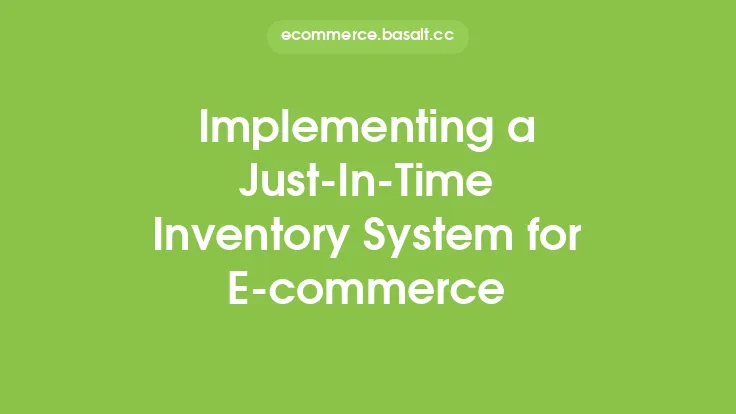Implementing a just-in-time (JIT) inventory system can be a game-changer for e-commerce businesses, allowing them to optimize their stock levels, reduce waste, and improve customer satisfaction. A JIT inventory system is a strategy that involves ordering and receiving inventory just in time to meet customer demand, rather than holding large quantities of stock in a warehouse. This approach requires careful planning, coordination, and communication with suppliers, but the benefits can be significant.
Understanding the Principles of Just-In-Time Inventory
To implement a JIT inventory system, it's essential to understand the underlying principles. The core idea is to produce and deliver products just in time to meet customer demand, rather than producing them in advance and storing them in a warehouse. This approach requires a deep understanding of customer demand, production lead times, and supplier capabilities. By analyzing historical sales data, seasonality, and market trends, e-commerce businesses can forecast demand and adjust their inventory levels accordingly.
Assessing Your Business Readiness for JIT Inventory
Before implementing a JIT inventory system, e-commerce businesses need to assess their readiness for this approach. This involves evaluating their current inventory management processes, supplier relationships, and production capabilities. Businesses should ask themselves questions like: Do we have a reliable and efficient supply chain? Can we accurately forecast demand? Do we have the necessary technology and infrastructure to support JIT inventory management? By answering these questions, businesses can identify potential bottlenecks and develop strategies to address them.
Setting Up a JIT Inventory System
Setting up a JIT inventory system requires several key steps. First, e-commerce businesses need to identify the products that are best suited for JIT inventory management. These are typically high-demand products with short lead times and low inventory holding costs. Next, businesses need to establish relationships with reliable suppliers who can deliver products quickly and efficiently. This may involve negotiating with suppliers to reduce lead times, improve quality, and increase flexibility. Businesses also need to implement a robust inventory management system that can track inventory levels, monitor demand, and automate ordering processes.
Managing Inventory Levels and Demand
Managing inventory levels and demand is critical to the success of a JIT inventory system. E-commerce businesses need to continuously monitor sales data, seasonality, and market trends to forecast demand and adjust inventory levels accordingly. This may involve using statistical models, machine learning algorithms, or other advanced analytics techniques to predict demand. Businesses also need to implement a system for tracking inventory levels, including the use of barcode scanning, RFID tags, or other automated tracking technologies.
Implementing a Vendor-Managed Inventory (VMI) System
One way to implement a JIT inventory system is to use a vendor-managed inventory (VMI) system. In a VMI system, the supplier is responsible for managing the inventory levels of the e-commerce business. The supplier uses historical sales data and other information to forecast demand and adjust inventory levels accordingly. This approach can be beneficial for e-commerce businesses that lack the resources or expertise to manage their own inventory. However, it requires a high degree of trust and cooperation between the business and the supplier.
Monitoring and Evaluating JIT Inventory Performance
To ensure the success of a JIT inventory system, e-commerce businesses need to continuously monitor and evaluate performance. This involves tracking key metrics such as inventory turnover, fill rates, and lead times. Businesses should also monitor supplier performance, including delivery times, quality, and reliability. By analyzing these metrics, businesses can identify areas for improvement and make adjustments to their JIT inventory system as needed.
Overcoming Common Challenges
Implementing a JIT inventory system can be challenging, and e-commerce businesses may encounter several common obstacles. One of the biggest challenges is managing demand variability, which can make it difficult to forecast demand and adjust inventory levels accordingly. Businesses may also encounter supply chain disruptions, such as natural disasters, transportation delays, or supplier insolvency. To overcome these challenges, businesses need to develop contingency plans, diversify their supplier base, and invest in supply chain visibility and risk management technologies.
Best Practices for JIT Inventory Management
To get the most out of a JIT inventory system, e-commerce businesses should follow several best practices. First, they should prioritize communication and collaboration with suppliers, including regular meetings, progress updates, and performance reviews. Businesses should also invest in advanced analytics and forecasting technologies to improve demand forecasting and inventory management. Additionally, businesses should focus on building a flexible and agile supply chain that can respond quickly to changes in demand or supply. By following these best practices, e-commerce businesses can optimize their JIT inventory system and achieve significant improvements in efficiency, customer satisfaction, and profitability.




